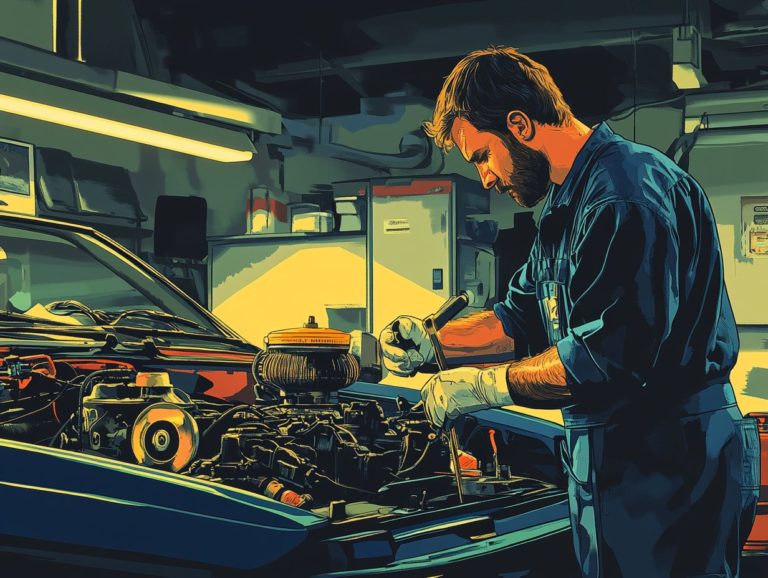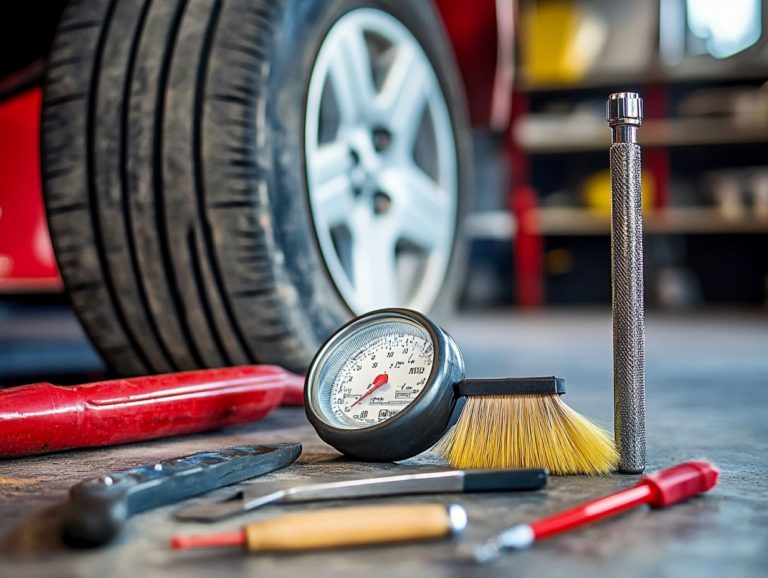How to Clean Your Car’s Engine Bay
Cleaning your car’s engine bay is frequently overlooked, yet it plays a crucial role in maintaining your vehicle’s performance and longevity.
A spotless engine not only enhances aesthetics but also helps avert problems caused by dirt and debris. This guide will walk you through the essential steps to prepare and clean your engine bay, including the supplies you’ll need and precautions to protect sensitive components.
You’ll also find valuable tips for keeping that pristine condition intact.
Are you ready to give your engine the care it deserves? Don t wait let s dive in and get started today!
Contents
- Key Takeaways:
- Why is it Important?
- Preparing Your Engine Bay for Cleaning
- Step-by-Step Guide to Cleaning Your Engine Bay
- Maintenance Tips for a Clean Engine Bay
- Frequently Asked Questions
- What supplies do I need to clean my car’s engine bay?
- Is it safe to use water when cleaning my car’s engine bay?
- How often should I clean my car’s engine bay?
- Can I use regular household cleaners to clean my car’s engine bay?
- Do I need to cover the battery before cleaning my car’s engine bay?
- Is it necessary to dry the engine bay after cleaning?
Key Takeaways:
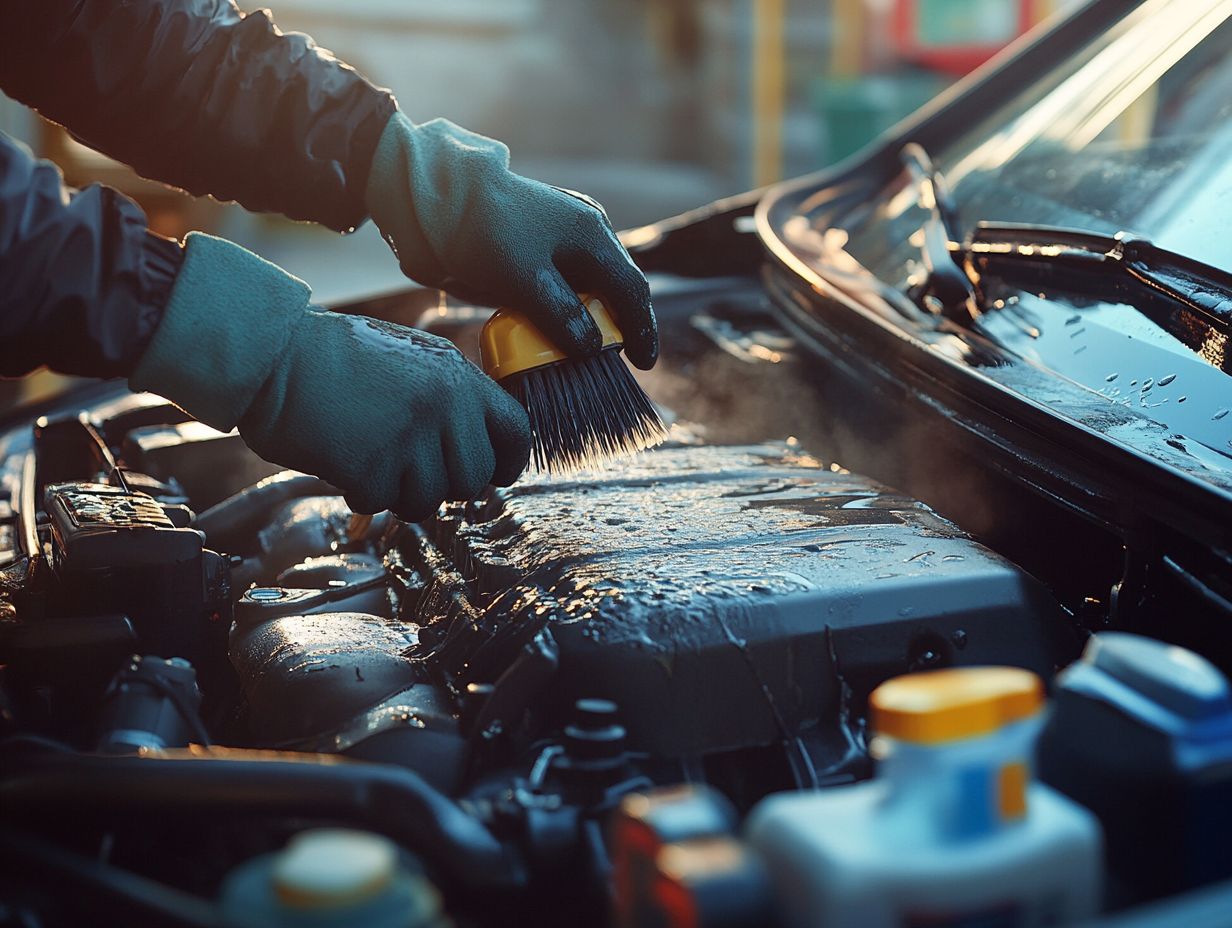
- Clean your car s engine bay regularly to maintain its performance and prolong its lifespan.
- Before starting, gather all necessary supplies and protect sensitive components from water damage.
- Follow a step-by-step guide: remove debris, use a strong cleaner for tough oil and grease, and thoroughly rinse and dry the area.
- To maintain a clean engine bay, clean it at least once a year and check and replace necessary components regularly to prevent build-up and damage.
Why is it Important?
Cleaning your car’s engine bay is essential for preserving the overall health and performance of your vehicle. A clean engine bay not only enhances aesthetics but also protects vital components, ensuring smooth operation for years to come.
By preventing the build-up of dirt and grime, you safeguard against corrosion and overheating, which could negatively impact its resale value. Additionally, regular maintenance simplifies troubleshooting and contributes to the longevity of your vehicle.
Therefore, dedicating time to automotive detailing is an investment that pays off in the long run.
Preparing Your Engine Bay for Cleaning
Preparing your engine bay is key to a safe and effective wash! This preparation safeguards sensitive components while enhancing your overall detailing experience.
Begin by gathering all the necessary tools think pressure washer, strong cleaner for tough oil and grease, and detailing brushes. Don t forget to place protective coverings over critical areas like the battery and electrical components to shield them from water and chemicals.
A well-prepared engine bay not only streamlines your cleaning process but also results in a cleaner and safer engine environment.
Gathering Necessary Supplies
Gathering the necessary supplies is essential for achieving a successful engine bay cleaning. This ensures you have all the right tools at your fingertips to effectively tackle dirt, grime, and debris.
To kick off this cleaning endeavor, a powerful degreaser is crucial for breaking down stubborn oil and grease buildup. Pair that with specialized wash soap to maintain the integrity of sensitive components.
Microfiber towels are your best friends for wiping away dirt without scratching surfaces, while detailing brushes help you access those tricky spots that are otherwise hard to clean. Don’t overlook the value of a vacuum cleaner; it can easily eliminate loose debris from tight spaces, ensuring a thorough job.
When it’s time to rinse, a pressure washer comes in handy, efficiently washing away remnants and leaving the engine bay looking pristine. Each of these tools contributes significantly to restoring your engine to its original, clean state.
Protecting Sensitive Components
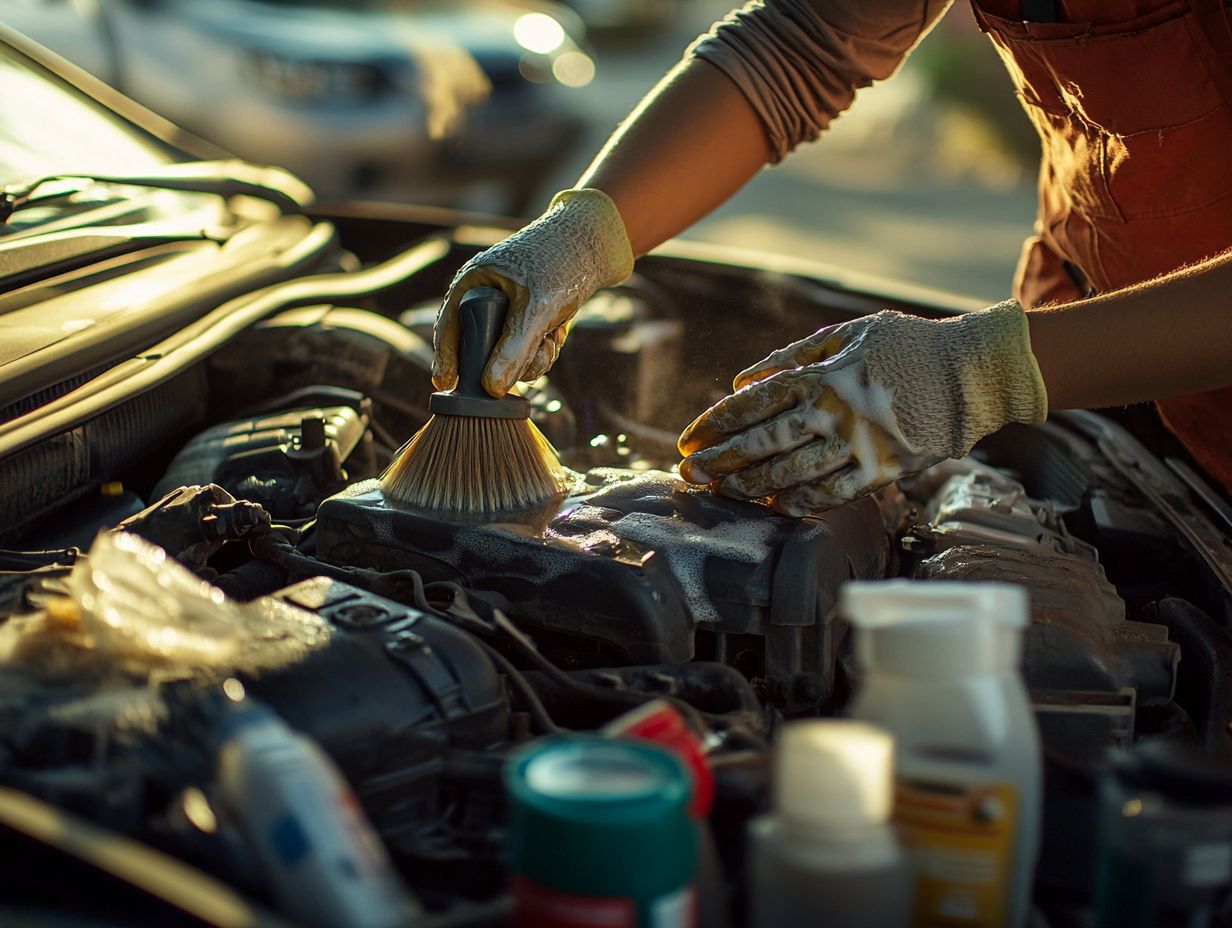
Protecting sensitive components during the engine bay cleaning process is essential. Water, chemicals, and dirt can wreak havoc on crucial parts like the battery, electrical systems, and hoses.
To ensure longevity and optimal performance, use protective methods like plastic covers or specialized protective coverings. These measures serve as effective barriers against harmful substances while also preventing moisture buildup that can lead to corrosion.
It s vital to shield these vulnerable areas from the harsh realities of cleaning products and water exposure; neglecting this can result in costly repairs or replacements.
By preparing properly and considering the materials used in the engine bay, you can help maintain the integrity and efficiency of your vehicle s components.
Step-by-Step Guide to Cleaning Your Engine Bay
A step-by-step guide on how to clean your car’s engine bay is crucial for anyone aiming to preserve their automotive investment. It allows you to conduct a thorough wash, ensuring that essential components are spotless and shielded from dirt and grime buildup.
This guide will walk you through each stage, from removing debris and dirt to rinsing and drying, helping you achieve an engine bay that looks fantastic and performs at its best.
By following these steps, you ll adopt a meticulous approach that enhances both the aesthetics and overall maintenance of your vehicle.
Removing Debris and Dirt
Removing dirt is the first step to a clean engine. It also helps prevent damage over time. To ensure your engine area is spotless, consider using a combination of brushes, vacuums, and clean cloths. This approach is incredibly effective.
For larger debris, a vacuum with a hose attachment is your best friend. It effortlessly reaches tight spaces where dirt loves to hide. Meanwhile, brushes excel at dislodging stubborn grime from crevices and components that need extra attention.
Don t overlook smaller, hard-to-reach areas. Using a microfiber cloth can help wipe down surfaces that might escape your standard cleaning methods. This initial cleaning enhances the engine bay’s overall appearance and protects your vehicle’s critical components against corrosion.
Get Ready to Power Wash That Grease Away!
Using a degreaser is essential for effectively cleaning your engine bay and tackling stubborn grease and grime that regular washing often overlooks.
You ll find a variety of degreasers available, each crafted for specific cleaning tasks. For example, cleaners that tackle tough residues work wonders, while solvent-based options break down oil and grease with ease.
When applying these products, it’s crucial to follow the manufacturer’s instructions for the best results. Whether you’re spraying directly onto the surface or diluting it for extensive applications, using the proper technique makes a difference.
Using a detailing brush makes a significant difference, allowing for thorough scrubbing in hard-to-access areas. This dual approach elevates cleanliness and ensures that hidden contaminants are effectively removed, promoting a pristine engine compartment.
Rinsing and Drying
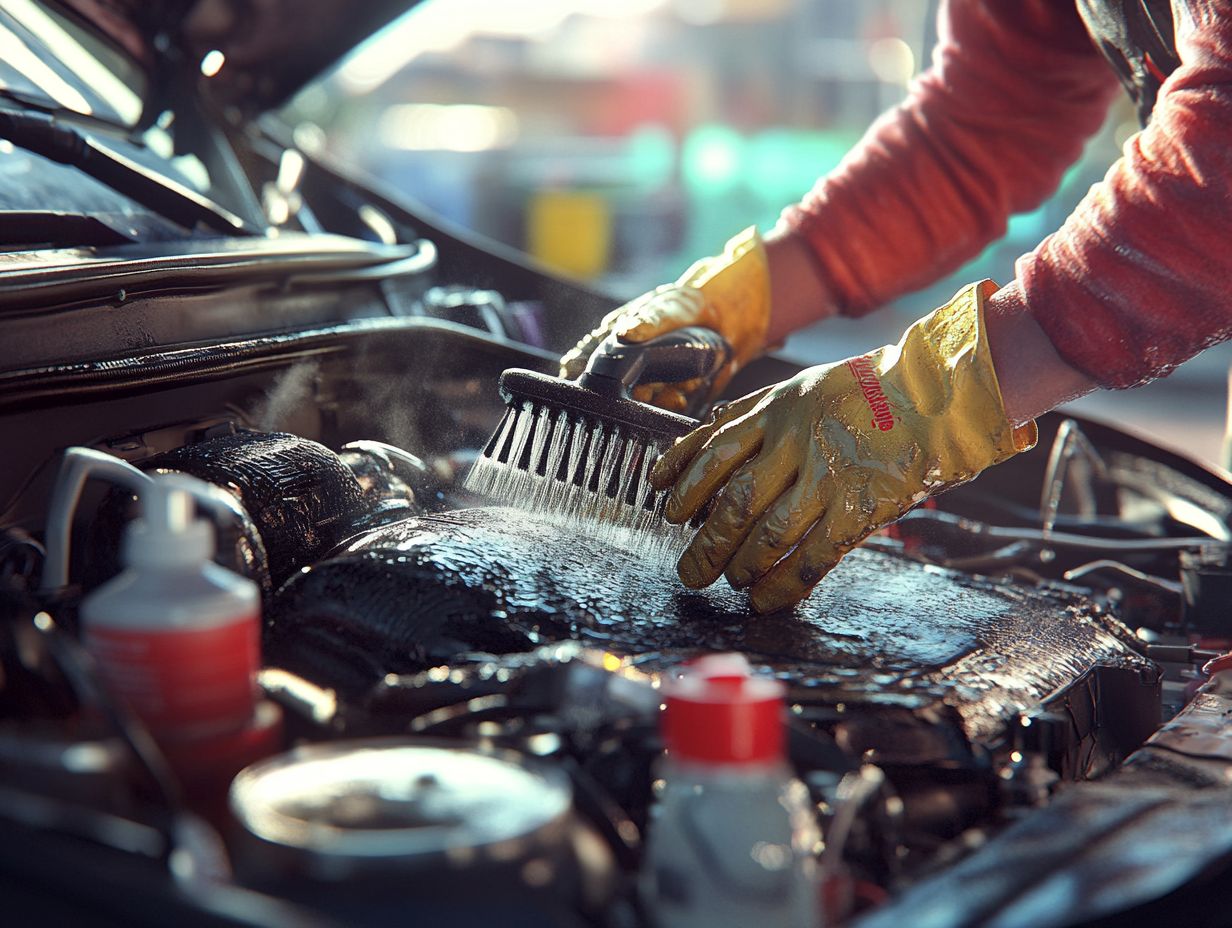
Rinsing and drying your engine bay after cleaning is essential to prevent any residue or water from accumulating, which could lead to corrosion or damage over time.
For rinsing, using a pressure washer at a moderate setting is your best bet. It effectively eliminates soap and dirt without risking harm to sensitive components. Maintain a safe distance from electrical parts and delicate areas to avoid any potential water intrusion.
After rinsing, using clean, dry cloths helps wipe away any lingering moisture, especially in hard-to-reach spots. Thorough drying is crucial to prevent rust and ensure all components work smoothly, keeping your vehicle in top shape.
By paying close attention to these details, you significantly enhance the longevity and performance of your engine and its parts.
Maintenance Tips for a Clean Engine Bay
Regular maintenance of your engine bay is essential for keeping it clean and functional. By adhering to a consistent schedule, you can effectively prevent the accumulation of dirt and grime, which could lead to potential damage.
Don t wait! Clean your engine bay today to keep your vehicle running smoothly!
How Often Should You Clean Your Engine Bay?
Establishing a regular cleaning schedule for your engine bay is crucial for maintaining both optimal performance and visual appeal.
The frequency of this maintenance can vary significantly based on several factors:
- How often you use your vehicle
- The driving conditions you encounter
- Whether you navigate harsh climates or engage in extensive off-road adventures
If you often find yourself driving in d dusty or muddy environments, a thorough cleaning every few months might be necessary. If your travels are primarily urban, a quick clean once or twice a year could suffice.
Neglecting this important task can lead to the accumulation of dirt and debris, impacting engine efficiency and resulting in costly repairs down the line. Taking proactive steps now will save you trouble and money later.
Preventing Build-up and Damage
You can easily prevent build-up and damage in your engine bay! Some straightforward yet effective practices can create a cleaner environment.
Regular inspections are essential, as they help you catch any dirt or grime accumulation early. This prevents issues that could arise later on. Prioritize cleaning intake areas and sensitive components, like electrical connections and wiring, to shield them from debris-related damage.
A soft brush paired with mild cleaning solutions can work wonders, keeping these areas pristine without causing harm. Applying a protective sealant can significantly reduce future build-up, ensuring your vehicle performs at its best while extending its lifespan.
Consistent maintenance is the cornerstone of a clean and functional engine bay.
Frequently Asked Questions
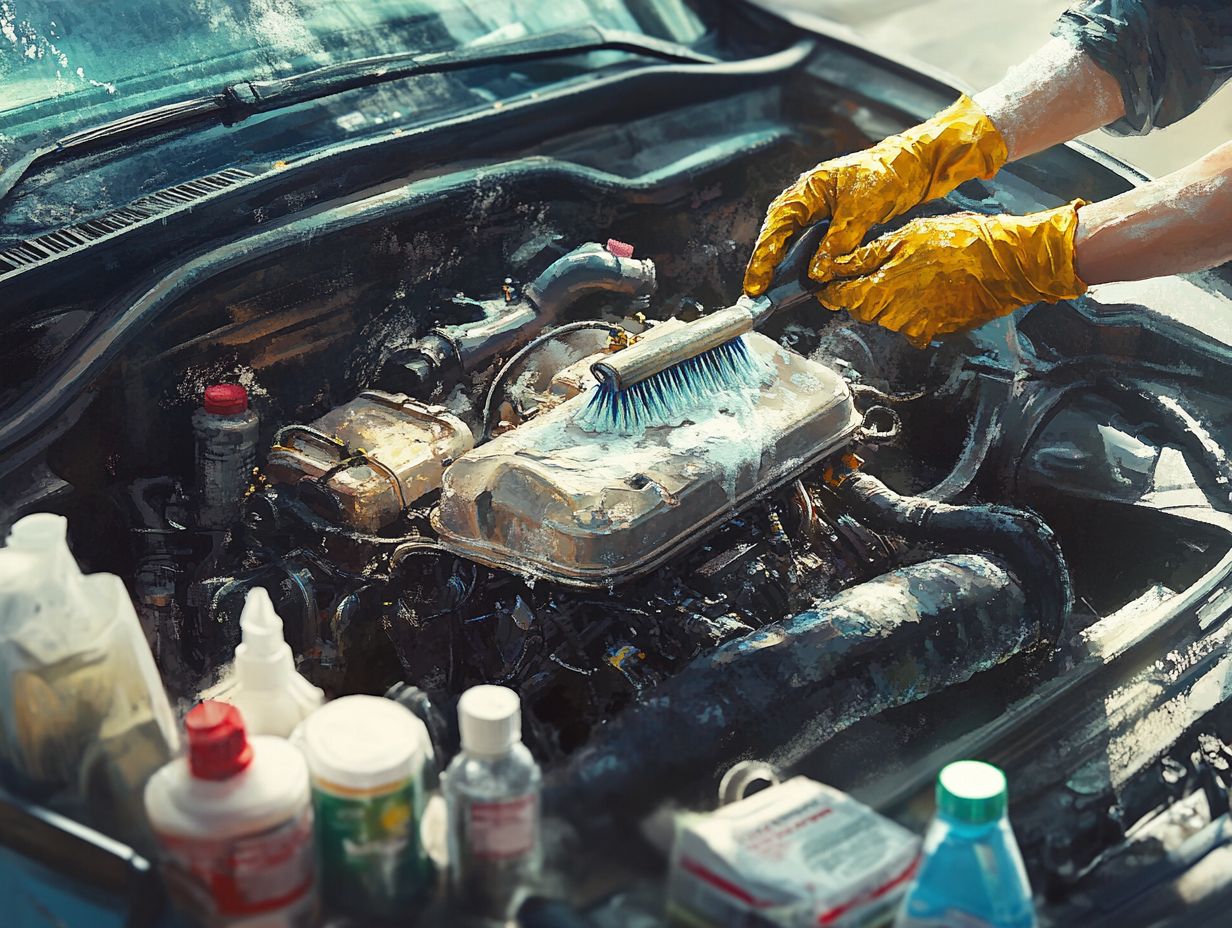
What supplies do I need to clean my car’s engine bay?
To properly clean your car’s engine bay, you will need the following supplies:
- A degreaser
- A bucket
- A hose
- A brush or sponge
- A microfiber cloth
- A protective cover for sensitive components like the alternator and fuse box
Is it safe to use water when cleaning my car’s engine bay?
Yes, it is safe to use water when cleaning your car’s engine bay. However, avoid using a high-pressure hose as it can damage sensitive components. Instead, use a gentle stream of water or a spray bottle to wet the engine bay before applying any cleaning products.
How often should I clean my car’s engine bay?
It is recommended to clean your car’s engine bay at least once a year. However, if you live in an area with harsh weather conditions or frequently drive on dusty roads, you may need to clean it more often.
Can I use regular household cleaners to clean my car’s engine bay?
No, it is not recommended to use regular household cleaners on your car’s engine bay. These cleaners may contain harsh chemicals that can damage sensitive components or leave residue that attracts dirt and grime. It is best to use a degreaser specifically designed for car engines.
Do I need to cover the battery before cleaning my car’s engine bay?
Yes, it is important to cover the battery before cleaning your car’s engine bay. This will prevent any cleaning products or water from damaging the battery or its connections. You can use a plastic bag or a special battery cover for this purpose.
Is it necessary to dry the engine bay after cleaning?
Yes, it is important to dry the engine bay after cleaning to prevent water spots and potential damage to electrical components. Use a microfiber cloth to gently dry the engine bay or let it air dry before starting the engine.
For more guidance, be sure to check out the video above, and schedule your next engine bay cleaning today!


